coolant reservoir Ram 1500 2020 Owner's Manual
[x] Cancel search | Manufacturer: RAM, Model Year: 2020, Model line: 1500, Model: Ram 1500 2020Pages: 674, PDF Size: 32.69 MB
Page 485 of 674
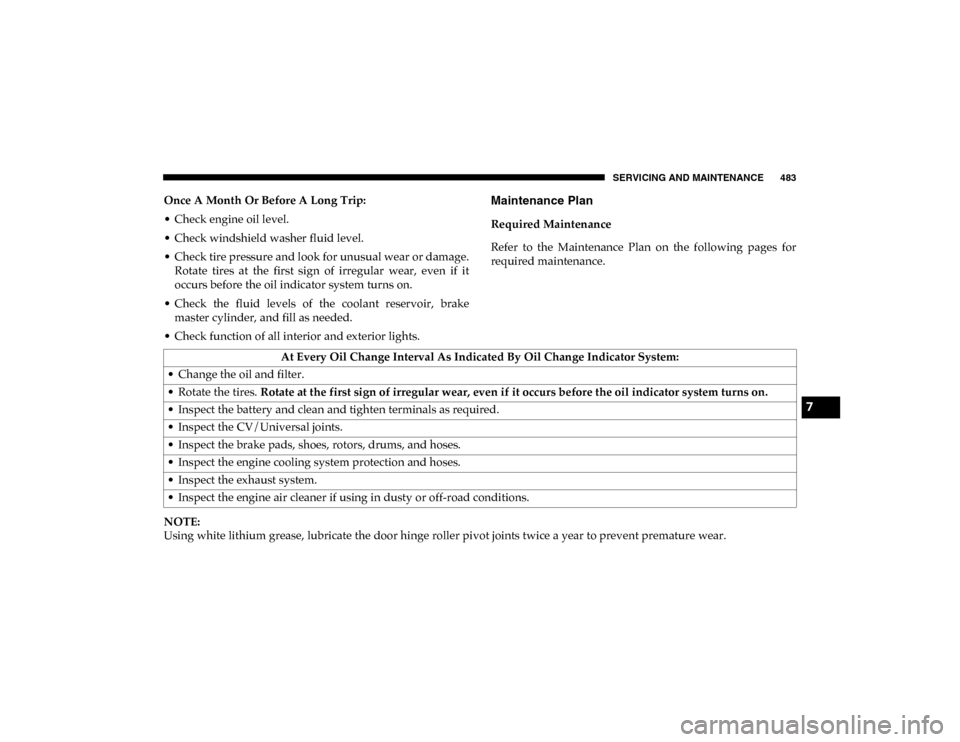
SERVICING AND MAINTENANCE 483
Once A Month Or Before A Long Trip:
• Check engine oil level.
• Check windshield washer fluid level.
• Check tire pressure and look for unusual wear or damage.Rotate tires at the first sign of irregular wear, even if it
occurs before the oil indicator system turns on.
• Check the fluid levels of the coolant reservoir, brake master cylinder, and fill as needed.
• Check function of all interior and exterior lights.Maintenance Plan
Required Maintenance
Refer to the Maintenance Plan on the following pages for
required maintenance.
NOTE:
Using white lithium grease, lubricate the door hinge roller pivot joints twice a year to prevent premature wear. At Every Oil Change Interval As Indicated By Oil Change Indicator System:
• Change the oil and filter.
• Rotate the tires. Rotate at the first sign of irregular wear, even if it occurs before the oil indicator system turns on.
• Inspect the battery and clean and tighten terminals as required.
• Inspect the CV/Universal joints.
• Inspect the brake pads, shoes, rotors, drums, and hoses.
• Inspect the engine cooling system protection and hoses.
• Inspect the exhaust system.
• Inspect the engine air cleaner if using in dusty or off-road conditions.
7
2020_DT_1500_OM_US.book Page 483
Page 489 of 674
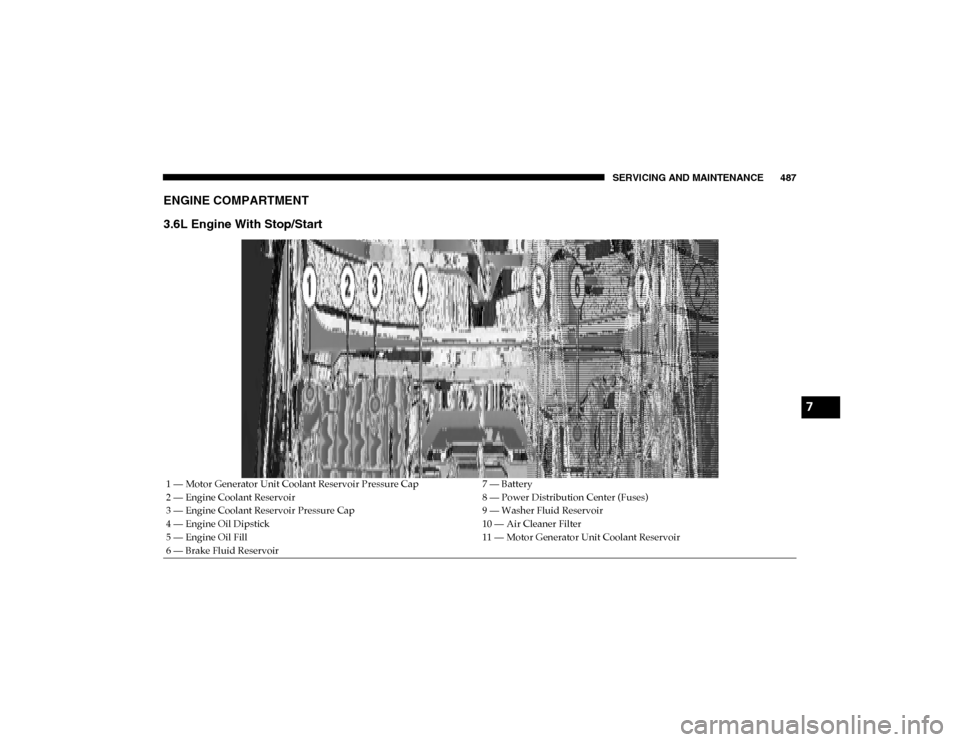
SERVICING AND MAINTENANCE 487
ENGINE COMPARTMENT
3.6L Engine With Stop/Start
1 — Motor Generator Unit Coolant Reservoir Pressure Cap7 — Battery
2 — Engine Coolant Reservoir 8 — Power Distribution Center (Fuses)
3 — Engine Coolant Reservoir Pressure Cap 9 — Washer Fluid Reservoir
4 — Engine Oil Dipstick 10 — Air Cleaner Filter
5 — Engine Oil Fill 11 — Motor Generator Unit Coolant Reservoir
6 — Brake Fluid Reservoir
7
2020_DT_1500_OM_US.book Page 487
Page 490 of 674
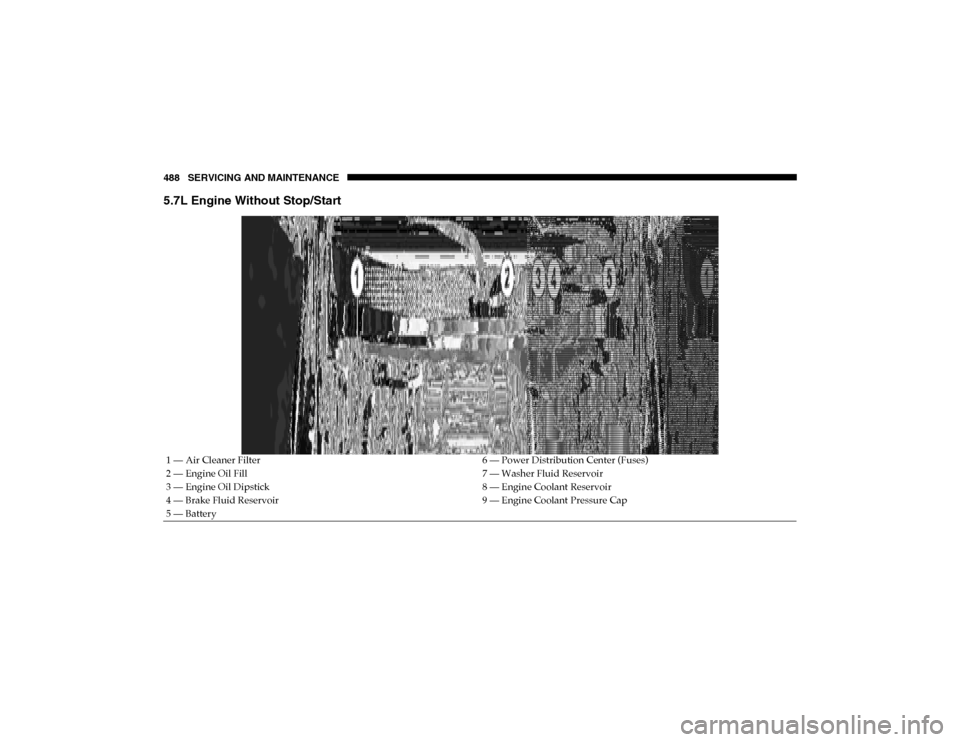
488 SERVICING AND MAINTENANCE
5.7L Engine Without Stop/Start
1 — Air Cleaner Filter6 — Power Distribution Center (Fuses)
2 — Engine Oil Fill 7 — Washer Fluid Reservoir
3 — Engine Oil Dipstick 8 — Engine Coolant Reservoir
4 — Brake Fluid Reservoir 9 — Engine Coolant Pressure Cap
5 — Battery
2020_DT_1500_OM_US.book Page 488
Page 491 of 674
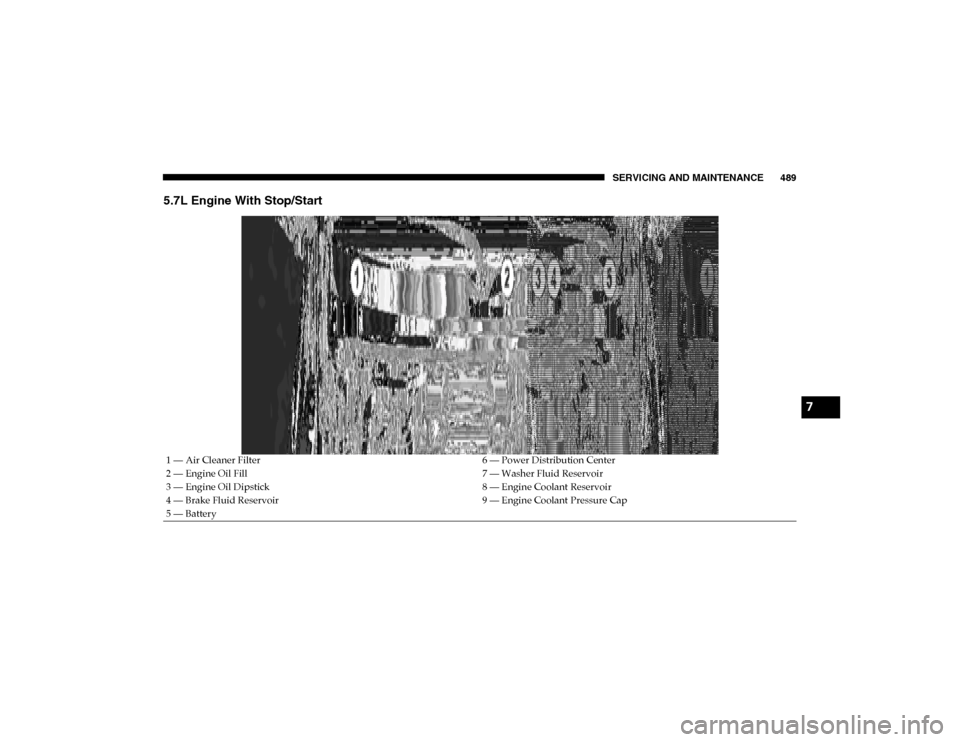
SERVICING AND MAINTENANCE 489
5.7L Engine With Stop/Start
1 — Air Cleaner Filter6 — Power Distribution Center
2 — Engine Oil Fill 7 — Washer Fluid Reservoir
3 — Engine Oil Dipstick 8 — Engine Coolant Reservoir
4 — Brake Fluid Reservoir 9 — Engine Coolant Pressure Cap
5 — Battery
7
2020_DT_1500_OM_US.book Page 489
Page 512 of 674
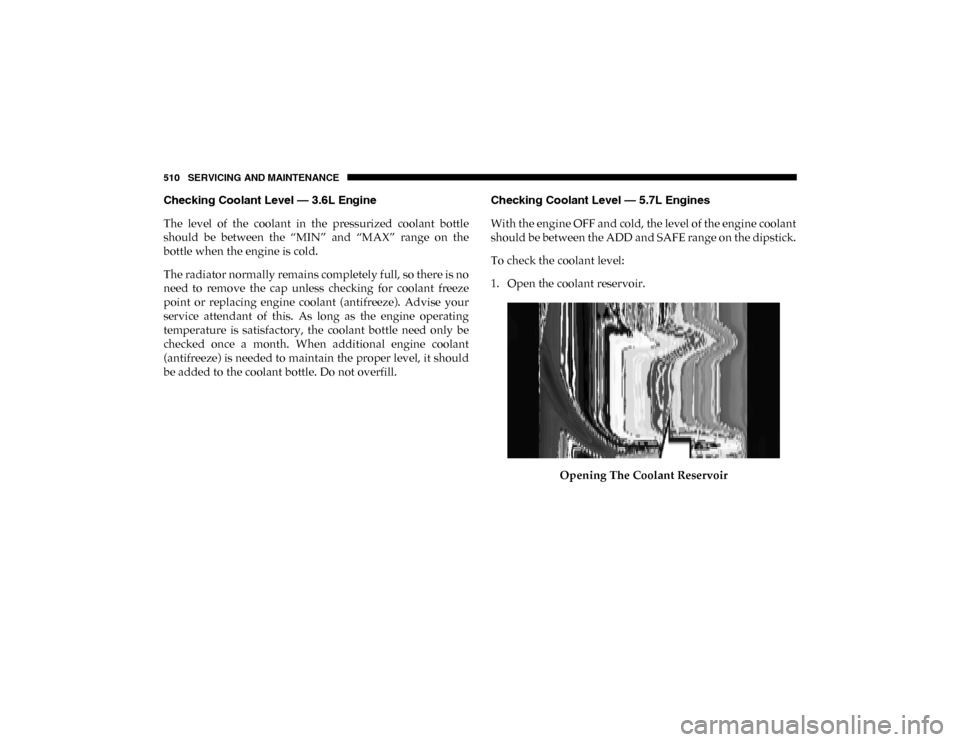
510 SERVICING AND MAINTENANCE
Checking Coolant Level — 3.6L Engine
The level of the coolant in the pressurized coolant bottle
should be between the “MIN” and “MAX” range on the
bottle when the engine is cold.
The radiator normally remains completely full, so there is no
need to remove the cap unless checking for coolant freeze
point or replacing engine coolant (antifreeze). Advise your
service attendant of this. As long as the engine operating
temperature is satisfactory, the coolant bottle need only be
checked once a month. When additional engine coolant
(antifreeze) is needed to maintain the proper level, it should
be added to the coolant bottle. Do not overfill.Checking Coolant Level — 5.7L Engines
With the engine OFF and cold, the level of the engine coolant
should be between the ADD and SAFE range on the dipstick.
To check the coolant level:
1. Open the coolant reservoir.
Opening The Coolant Reservoir
2020_DT_1500_OM_US.book Page 510
Page 513 of 674
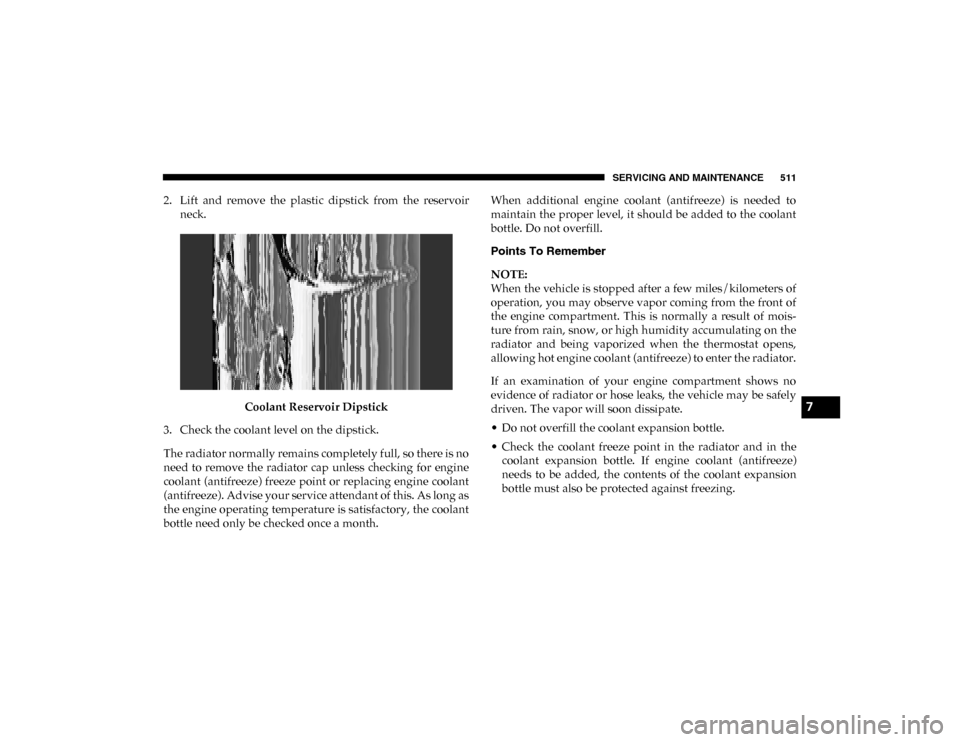
SERVICING AND MAINTENANCE 511
2. Lift and remove the plastic dipstick from the reservoirneck.
Coolant Reservoir Dipstick
3. Check the coolant level on the dipstick.
The radiator normally remains completely full, so there is no
need to remove the radiator cap unless checking for engine
coolant (antifreeze) freeze point or replacing engine coolant
(antifreeze). Advise your service attendant of this. As long as
the engine operating temperature is satisfactory, the coolant
bottle need only be checked once a month. When additional engine coolant (antifreeze) is needed to
maintain the proper level, it should be added to the coolant
bottle. Do not overfill.
Points To Remember
NOTE:
When the vehicle is stopped after a few miles/kilometers of
operation, you may observe vapor coming from the front of
the engine compartment. This is normally a result of mois
-
ture from rain, snow, or high humidity accumulating on the
radiator and being vaporized when the thermostat opens,
allowing hot engine coolant (antifreeze) to enter the radiator.
If an examination of your engine compartment shows no
evidence of radiator or hose leaks, the vehicle may be safely
driven. The vapor will soon dissipate.
• Do not overfill the coolant expansion bottle.
• Check the coolant freeze point in the radiator and in the coolant expansion bottle. If engine coolant (antifreeze)
needs to be added, the contents of the coolant expansion
bottle must also be protected against freezing.
7
2020_DT_1500_OM_US.book Page 511
Page 514 of 674
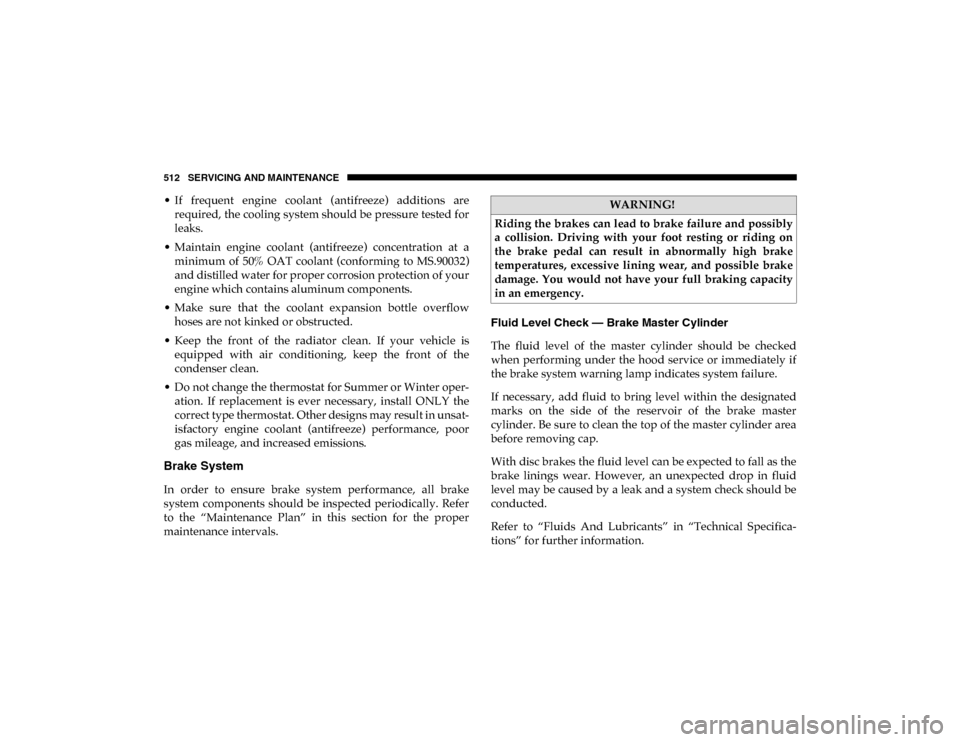
512 SERVICING AND MAINTENANCE
• If frequent engine coolant (antifreeze) additions arerequired, the cooling system should be pressure tested for
leaks.
• Maintain engine coolant (antifreeze) concentration at a minimum of 50% OAT coolant (conforming to MS.90032)
and distilled water for proper corrosion protection of your
engine which contains aluminum components.
• Make sure that the coolant expansion bottle overflow hoses are not kinked or obstructed.
• Keep the front of the radiator clean. If your vehicle is equipped with air conditioning, keep the front of the
condenser clean.
• Do not change the thermostat for Summer or Winter oper -
ation. If replacement is ever necessary, install ONLY the
correct type thermostat. Other designs may result in unsat -
isfactory engine coolant (antifreeze) performance, poor
gas mileage, and increased emissions.
Brake System
In order to ensure brake system performance, all brake
system components should be inspected periodically. Refer
to the “Maintenance Plan” in this section for the proper
maintenance intervals. Fluid Level Check — Brake Master Cylinder
The fluid level of the master cylinder should be checked
when performing under the hood service or immediately if
the brake system warning lamp indicates system failure.
If necessary, add fluid to bring level within the designated
marks on the side of the reservoir of the brake master
cylinder. Be sure to clean the top of the master cylinder area
before removing cap.
With disc brakes the fluid level can be expected to fall as the
brake linings wear. However, an unexpected drop in fluid
level may be caused by a leak and a system check should be
conducted.
Refer to “Fluids And Lubricants” in “Technical Specifica
-
tions” for further information.
WARNING!
Riding the brakes can lead to brake failure and possibly
a collision. Driving with your foot resting or riding on
the brake pedal can result in abnormally high brake
temperatures, excessive lining wear, and possible brake
damage. You would not have your full braking capacity
in an emergency.
2020_DT_1500_OM_US.book Page 512